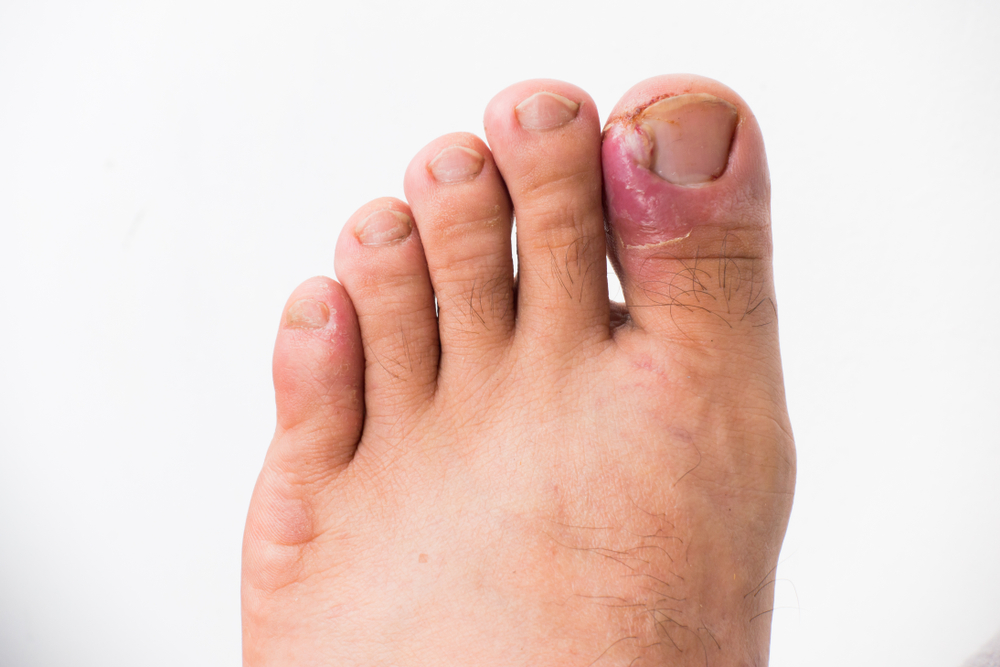Black Toenails
Athletes will often encounter a problem with their toenails turning dark. This may be due to the toes hitting the end or the top of the shoe toe area. Quite often the toenail may become loose and fall off. This can also occur in people who have worn a tight shoe for a prolonged period of time. The dark color is a result of bruising under the toenail. Generally it is not painful. The damage caused to the toenail may allow the establishment of a fungal infection in the nail. In people who have diabetes, any change in the color of the toenail should be evaluated by a doctor. The pressure, which caused the bruising of the nail, can cause a small sore under the toenail, which can become infected.
Treatment
Treatment might consist of trimming the loose nail back and applying a topical anti-fungal medication. If the skin under the nail is ulcerated, then a topical antibiotic ointment should be applied. Patients with diabetes should not treat this condition themselves and should seek the advice of a doctor.
Prevention consists of wearing properly fitting shoes and possibly stretching of the calf muscles. People who are involved in athletics and exercise often have excessively tight calf muscles. This results in the muscles in the front of the leg having to work harder to pull the foot upward. This forces the toes to impact the top of the toe with greater force, potentially causing the bruising of the toenail.
Article provided by PodiatryNetwork.com.
Fungal Toenails, Yellowed or Deformed Toenails
The most common cause of yellowed, thick and /or deformed toenails is a fungal infection of the toenail. The fungus that infects the nail, most commonly, is the same fungus that causes athletes foot. It tends to be slowly progressive, damaging the nail to a greater and greater degree over time. The infection usually starts at the tip of the nail and works its way back. It usually is not painful and often not noticed until it has gotten well established. A single toenail or any number of nails can be affected. It can also occur on just one foot. Over time, the nail becomes thickened, crumbly, and distorted in appearance. Sweaty feet contribute to the initial infection process and contribute to its spread. The fungus prefers an environment that is moist, dark, and warm, which is why it affects the toenails much more often than fingernails. It does not spread through the blood stream. The infection limits itself to the nails and skin. It is often found in association with areas of dry scaly skin on the bottom of the foot or between the toes. The dry scaling skin is frequently found to be chronic athletes’ foot. It is not highly contagious, and family members are almost as likely to contract it from some other source as they are from the family member who has the infection. Keeping common showering areas clean is recommended, and sharing shoes should be avoided.
Diagnosis
Not all thicken or yellowed toenails are caused by a fungal infection. Injury to a toenail can cause the toenail to grow in a thickened or malformed fashion. This can be due to an established fungal infection or may be due to the damage caused to the nail root when it was injured. In these instances, treatment with anti-fungal medications will not correct the malformed nail. Other causes of thickened toenails are small bone spurs that can form under the toenail and psoriasis. Taking a scraping of the toenail and culturing it makes the diagnosis.
Treatment
It is best to treat the condition as soon as it is noticed. In early cases, over the counter medications may be sufficient. It is also important to treat any concomitant athlete’s foot that may be present. In more advanced cases, a prescription medication may be needed. There are effective topical and oral medications available for the treatment of fungal toenails. If sweating feet are a problem, changing shoes and socks during the day is recommended. There are some topical medications available that help to reduce the sweating of the feet. On occasion, your doctor may recommend removing the toenail.
Article provided by PodiatryNetwork.com.
Ingrown Toenails
Ingrown toenails are due to the penetration of the edges of the nail plate into the soft tissue of the toe. It begins with a painful irritation that often becomes infected. With bacterial invasion, the nail margin becomes red and swollen often demonstrating drainage or pus. In people who have diabetes or poor circulation, this relatively minor problem can be become quite severe. In this instance, a simple ingrown toenail can result in gangrene of the toe. Patients with joint replacements or pace makers are at risk of bacterial spread through the blood stream resulting in the spread of infection to these sites. These patients should seek medical attention at the earliest sign of an ingrown toenail. There are several causes of ingrown toenails: a hereditary tendency to form ingrown toenails, improperly cutting the toenails either too short or cutting into the side of the nail, and ill-fitting shoes can cause them. Children will often develop ingrown toenails as a result of pealing or tearing their toenails off instead of trimming them with a nail clipper. Once an ingrown toenail starts, they will often reoccur. Many people perform “bathroom” surgery to cut the nail margin out only to have it reoccur months later as the nail grows out.
Treatment
Treatment for ingrown toenails is relatively painless. The injection to numb the toe may hurt some, but a skilled doctor has techniques to minimize this discomfort. Once the toe is numb, the nail margin is removed and the nail root in this area is destroyed. Most commonly, the doctor will use an acid to kill the root of the nail, but other techniques are also available. It may take a few weeks for the nail margin to completely heal, but there are generally no restrictions in activity, bathing, or wearing shoes. Once the numbness wears off, there may be some very mild discomfort but rarely does this require pain medicine. A resumption of sports activities and exercise is generally permitted the following day.
There are very few complications associated with this procedure. Reoccurrence of the ingrown toenail can occur a small percentage of the time. Continuation of the infection is possible which can be controlled easily with oral antibiotics. On occasion, the remaining nail may become loose from the nail bed and fall off. A new nail will grow out to replace it over several months. With removal of the nail margin, the nail will be narrower and this should be expected.
To prevent ingrown toenails it is recommended to wear properly fitting shoes and to trim the toenails straight across and not too short.
Article provided by PodiatryNetwork.com.
| DISCLAIMER: MATERIAL ON THIS SITE IS BEING PROVIDED FOR EDUCATIONAL AND INFORMATION PURPOSES AND IS NOT MEANT TO REPLACE THE DIAGNOSIS OR CARE PROVIDED BY YOUR OWN MEDICAL PROFESSIONAL. This information should not be used for diagnosing or treating a health problem or disease or prescribing any medication. Visit a health care professional to proceed with any treatment for a health problem. |

